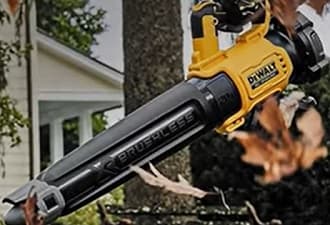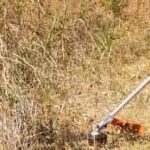As an Amazon Associate, this site earns commissions from qualifying purchases. For more information click here.
Have you ever seen a leaf blower engine seize up? It can happen to different types and when it does, figuring out the cause can be difficult. Since you came here looking for solutions, we have compiled the most common causes and also the best fixes.
A leaf blower engine seizes up due to a damaged cylinder or defective spark plug. Putting the wrong fuel mixture, a dirty cooling fin or clogged exhaust system can also cause a 2-stroke engine to lock up.
Before anything else, have your leaf blower owner’s manual nearby. Follow all safety precautions and perform the following only if you are knowledgeable about engine parts. Wear gloves, eye protection and other safety gear especially when dealing with gas engines.
Damaged Piston and Cylinder
A damaged cylinder will lead to an engine seizure. The damage can occur due to wear and tear or other reasons. If the engine won’t start, the cylinder is probably done for.
The cylinder feeds gas to the crankcase which allows the engine to start. So if there is an issue with the cylinder, the engine will not work.
How to fix it. There are two options: replace the cylinder or fix it. Replacing the cylinder is usually cheaper and more practical.
If you spend enough money it is possible to repair a broken cylinder. The problem is that you might end up spending just as much (if not more) to buy a new one.
If you have a good quality leaf blower like the Husqvarna 965877502 backpack blower, odds are the cylinder breaks down due to age. If that happens it was probably bound for a replacement.
Cylinders are complicated and it is rarely just about repairing one part. Often you will need to fix the cylinder and maybe get new gaskets, seals, ring etc. If you are going to replace all those, might as well get a new cylinder.
Cylinder and Piston Clogged by Old Fuel
If you left fuel in the engine for more than a month, it will turn sticky. This substance gets all over the engine and can clog the piston and cylinder.
If the two are stuck, there is no way for the engine to start. Old fuel not only affects the cylinders and pistons, but can also clog the carburetor, spark plug, filters etc.
How to fix it. Shut the leaf blower down. Drain whatever fuel is left in the tank. Open the fuel tank and pour hot water in it. Add soap or detergent to the water. While you are doing this, check the cap for clog. Remove if there is any.
Remove the water and inspect the tank. Use a stiff brush to remove any debris left. Wait for the tank to dry before filling it with fresh fuel. If you are using a 2-stroke leaf blower, add the appropriate mix.
Spark Plug Not Working
A misfiring spark plug can cause a cylinder to malfunction. These plugs get worn out, burn out or just stop working for various reasons. This is a problem that can affect Echo leaf blowers too. If you have issues getting your Echo leaf blower to start, this guide can help.
When that happens, the cylinder may stop working or the ignition coil loses power. Either one of those is enough to seize a 2-stroke engine.
How to fix it. Check the spark plug (use your owner’s manual for guidance to find it). If the ends look burned or covered with dirt, it is time to get a replacement.
Remove the spark plug and show it to the vendor, who should know which one to get. You can also visit the manufacturer website and order a spark plug.
If the spark plug is new and clean, run the Lisle Spark Tester. If there is no spark, you need to get a replacement. But if there is a spark, the engine problem lies somewhere else.

Dirty Cooling Fins
Leaf blower engines can get really hot which is why they have cooling fins. These fins allow air to move into the system, lowering the temperature as it runs.
Eventually, dirt, debris, dust and other materials build up on the fins. This can lead to overheating and cause the engine to stall. As the dirt accumulates and the engine overheats, it will eventually cause severe damage.
How to fix it. Use a stiff brush to wipe the dirt. Clean frequently to prevent dirt from sticking to the fins, which are hard to remove. You should clean the fins at least once a month, but do it more often if your leaf blower is heavily used.
In some leaf blowers you have to remove a cover or case to access the cooling fins. Other models do not so check your owner’s manual for details.
Wrong Fuel Mix
A 2-stroke engine requires a mixture of gas and oil. The ratio for most blowers is 50:1 but others use 40:1 or 32:1. if you put straight gas into the tank, the engine can lock up and suffer severe damage.
Putting the wrong fuel mix into a leaf blower will at the very least, cause the engine to stall. Worst case scenario it leads to structural damage.
How to fix it. Prevention is the key here. If it is a 2-stroke engine remember to mix gas and oil. Use the ratio suggested by the manufacturer. If the manual says 50:1 and use regular unleaded 87 octane, that is what you should use.
If you pour straight gas and realized the mistake, shut the leaf blower down. Empty the fuel tank and pour the proper mix this time.
Air Filter is Faulty
Leaf blowers have air filters to reduce internal heat and prevent debris from clogging the engine. Most air filters are made from paper or a foam-like material. Foam filters are better because they can be cleaned and reused, while paper is one-time use only.
As with most engine parts, air filters tend to get clogged with leaves, dirt, and debris. As debris covers the filter, it can no longer function normally.
How to fix it. Remove the air filter cover and lift the filter out. If it is paper, you have to replace it. If it is foam or something similar, you can clean it up. Immerse the filter in soapy water or water with detergent.
Let the water remove the dirt. Put the filter back on when it is dry. If the dirt does not come off, replace the filter. Even a well-designed leaf blower will need to have its air filters replaced at some point.
Most air filters have to be replaced every 12 months. This is not a hard rule. If you rarely use your blower, the filter will last longer. But if you use it a lot, more frequent replacements are required.
Exhaust, Muffler and Spark Arrestor Needs Cleanup
The muffler on your leaf blower works the same way as those on cars. It reduces the noise produced by the fuel as it escapes the engine. The spark arrestor is part of the exhaust system and is designed to prevent fires in case the engine malfunctions.
The spark arrestor screen filters debris, but it gets clogged with dirt at some point. When that happens the engine will overheat and suffer damage.
How to fix it. Shut off the leaf blower and remove the muffler. You should see the spark arrestor screen now.
Mix water and detergent in a container and clean the screen. Let it dry naturally.
Replace the spark arrestor screen if dirt won’t come off. This can happen with a really dirty exhaust system. As you wait for the screen to dry, wipe the exhaust port with a scraping utility.
Old fuel left in the fuel tank can leave scorch marks on the muffler. Check each part of the exhaust system before cleaning it. Depending on the situation, some might need a replacement.

I love the outdoors and all the tools for maintaining gardens, yards and lawns. The only thing I am more passionate about is sharing what I know about garden and outdoor equipment.


